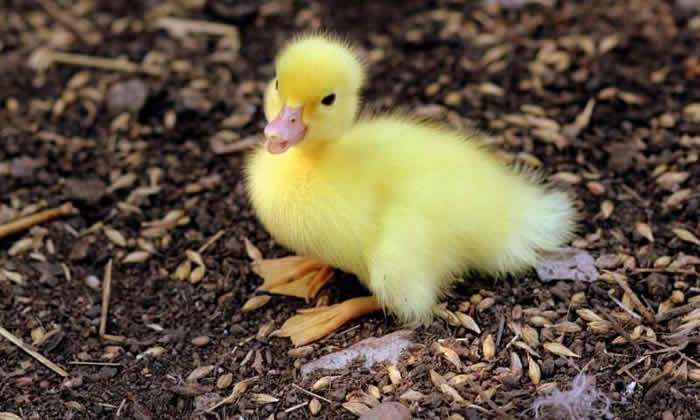Newly hatched ducklings which are shown a substitute mother object with only one eye, will not recognize it when they have only the other eye available.
Ducklings and other fowl normally learn to follow their mother within a few minutes of seeing her, through a process called imprinting.
This process can allow a duckling to learn to identify any moving object presented to it during its ‘sensitive’ period – typically within the first week or so after hatching.
Scientists from the University of Oxford conducted the study, published in the journal Animal Behavior, in which ducklings were initially presented with either a red or a blue duck decoy, which moved in a circular path, while wearing an eye patch over one eye.
The ducklings ‘imprinted’ on this maternal surrogate, learning with this first eye to follow the colored decoy they had been presented with. In subsequent choice tests over the next three hours, each duckling was presented with both the red and blue decoys simultaneously while wearing no eye patch, a patch over the same eye as in training, or a patch over the other eye – the one that had seen the decoy during training.
The ducklings that made their choice with both eyes, or with the same eye with which they had been trained, accurately preferred to follow the original decoy. But the ducklings wearing a patch over the original eye, so that only the naive eye was available during testing, showed no reliable preference between the two decoys.
The researchers say the results tell us something about how birds’ brains work. In most mammals there is a large bridge connecting the two halves of the brain called the corpus callosum. This structure allows rapid transfer of information between the two brain hemispheres, including information arriving from the visual system. In birds and other vertebrates, however, there is no equivalent structure, and the direct inputs from each eye go to the opposite side of the brain. That means information obtained with one eye has to follow more complex anatomical routes to become available to the other.
This new experiment shows that this anatomical difference means that when a duck gathers visual information with one eye, even something as important as learning to identify its mother, that information, in the short term, is not available when behavior is controlled by the other eye. For some time at least, a bird may be visually informed with one eye and naive with the other.
Furthermore, these two competing banks of information can cause internal conflicts. In a second experiment, ducklings were imprinted on opposite decoys with each eye (for example, the blue decoy with the left eye and the red decoy with the right eye). When tested with each eye individually, the ducklings preferred the decoy appropriate to that eye, albeit more weakly than in the first experiment – as if they retrieved one representation of their mother with the left eye and another with the right eye. When tested with both eyes, they did not show a preference, suggesting the possibility that the left and right imprints were neutralizing each other.
Professor Alex Kacelnik of Oxford University’s Department of Zoology said: “This result illustrates the diversity of the kinds of minds possessed by different organisms. The mental experience of a bird is likely to be profoundly different from our own, and we are still far from having a clear picture of it.”
Kacelnik continued: “As mammals, the idea that when using one eye we may not be able to identify things first seen by the other eye seems very strange, but this is probably what happens to birds and most other vertebrates including reptiles, amphibians and fish. Since only eutherian mammals – that is, excluding marsupials such as kangaroos, and monotremes like the platypus – have a corpus callosum, it is possible that the unified visual mind may be a mammalian innovation.”
Antone Martinho, a Research fellow in Oxford’s Department of Zoology and the study’s first Author, said: “When a bird sees something with both eyes simultaneously, each memory bank can acquire the same new information, and so the duck can act as though the two brain halves are informed. What is startling about our result, though, is that monocular viewing will often be the norm for many birds, especially those with laterally placed eyes. Consequently, the situation presented in our study – that of a bird with two banks of differing, nonintegrated visual information – will be fairly common.”
Martinho added: “Most birds live a fast-paced life. Many are primarily prey animals needing to respond to a sighted predator at a moment’s notice, all while each eye is sending different images to the brain. Furthermore, most birds fly. It is somewhat baffling to think that a flying bird may be acting in such a coordinated manner with two separate banks of information in its brain vying for behavioral control.”
More information: University of Oxford.


Comments are closed, but trackbacks and pingbacks are open.